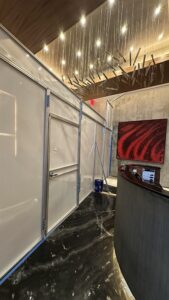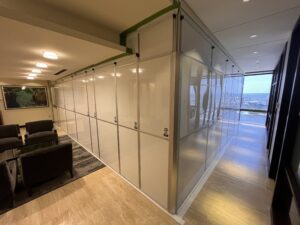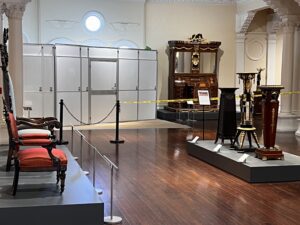Temporary Walls in Lab & Cleanroom Settings: Particle Control Essentials
Laboratory and cleanroom environments demand the highest standards of contamination control, where even microscopic particles can compromise research integrity, product quality, and regulatory compliance. Temporary walls have emerged as a critical solution for facility managers who need to maintain these stringent environmental standards while accommodating construction, renovations, or space reconfigurations.
These modular barrier systems provide immediate contamination control without the expense and permanence of traditional construction. For facility managers overseeing sensitive environments, understanding how temporary walls contribute to particle control can mean the difference between maintaining operations and costly shutdowns during facility modifications.
Why Use Temporary Walls in Controlled Environments?
Temporary walls offer facility managers several distinct advantages when managing laboratory and cleanroom spaces that require ongoing particle control.
Cost-Effectiveness Without Compromise
Traditional construction methods for creating containment barriers can cost thousands of dollars and require weeks of planning and execution. Temporary wall systems provide immediate installation at a fraction of the cost, allowing you to allocate budget resources more efficiently across multiple facility management priorities.
The rental model eliminates the need for long-term storage of construction materials and reduces waste associated with permanent modifications that may become obsolete as your facility’s needs evolve.
Operational Flexibility
Laboratory and cleanroom requirements change frequently due to research priorities, equipment upgrades, or regulatory updates. Temporary walls adapt to these shifting needs without requiring major construction permits or lengthy approval processes.
Our modular systems can be reconfigured, expanded, or relocated as your containment requirements change. This flexibility proves particularly valuable during phased renovations where different areas require isolation at different times.
Rapid Deployment with Minimal Disruption
Time-sensitive research and production schedules cannot accommodate extended downtime. Temporary wall installation typically occurs within hours rather than days or weeks, allowing critical operations to continue with minimal interruption.
The installation process generates significantly less dust, noise, and debris compared to traditional construction, which is essential when working adjacent to active laboratory or cleanroom spaces.
Particle Control: The Foundation of Clean Environments
Effective particle control forms the cornerstone of laboratory and cleanroom operations, directly impacting research accuracy, product quality, and regulatory compliance.
Understanding Particle Control Requirements
Particles in controlled environments come from various sources: personnel movement, equipment operation, construction activities, and external infiltration. These contaminants can range from visible dust to submicron particles that interfere with sensitive processes.
Different laboratory and cleanroom classifications require specific particle count limits. A Class 100 cleanroom, for instance, permits no more than 100 particles of 0.5 microns or larger per cubic foot of air. Maintaining these standards during facility modifications requires robust containment strategies.
ISO Standards and Regulatory Compliance
International Organization for Standardization (ISO) 14644 standards define cleanliness classifications for controlled environments. These standards specify maximum allowable particle concentrations for different cleanliness classes, providing facility managers with clear benchmarks for environmental control.
Temporary walls designed for cleanroom applications must support these ISO requirements by providing:
- Sealed barrier systems that prevent particle migration
- Smooth, non-shedding surfaces that won’t contribute additional contamination
- Integration capabilities with existing HVAC and filtration systems
- Documentation and validation support for regulatory inspections
How Temporary Walls Achieve Particle Control
Modern temporary wall systems incorporate several design features specifically engineered for particle control in sensitive environments.
Sealed Construction: Professional-grade temporary walls utilize gaskets, seals, and tight-fitting joints to create continuous barriers that prevent particle migration between spaces. This sealed construction maintains the integrity of controlled environments even during adjacent construction activities.
Material Selection: Temporary walls for cleanroom applications use non-porous, smooth materials that resist particle accumulation and allow for effective cleaning and decontamination. These materials meet outgassing requirements to prevent chemical contamination in sensitive processes.
Pressure Differential Management: Properly installed temporary walls work in conjunction with existing HVAC systems to maintain required pressure differentials between spaces. This pressure management prevents contaminated air from infiltrating clean areas.
Integration with Filtration Systems: Advanced temporary wall systems can incorporate HEPA filtration units, pass-through chambers, and airlocks to create complete containment solutions that support ongoing operations while isolating construction or maintenance activities.
Implementation Considerations for Facility Managers
Successful particle control through temporary walls requires careful planning and coordination with your facility’s existing systems and operational requirements.
Assessment and Planning
Before installation, conduct a thorough assessment of your facility’s specific particle control needs. Consider factors such as:
- Current cleanliness classification requirements
- Adjacent space sensitivities
- HVAC system integration points
- Personnel and equipment access requirements
- Duration of containment needs
This assessment ensures the temporary wall solution aligns with your operational priorities and regulatory obligations.
Professional Installation and Validation
Proper installation directly impacts the effectiveness of particle control measures. Professional installation teams understand the critical sealing requirements and system integration necessary for maintaining controlled environments.
Post-installation validation through particle counting and pressure differential testing confirms that the temporary barriers meet your facility’s specific requirements. This documentation supports regulatory compliance and provides assurance that your containment strategy is effective.
Maintaining Clean Operations During Facility Changes
Temporary walls enable facility managers to maintain operational continuity while addressing necessary facility modifications, equipment installations, or maintenance activities.
The key lies in creating effective containment strategies that isolate potentially contaminating activities while preserving the controlled environment integrity of active laboratory and cleanroom spaces. This approach allows critical research and production activities to continue without compromising quality or compliance standards.
With proper planning and professional implementation, temporary walls provide the particle control foundation necessary for successful facility management in sensitive environments.


